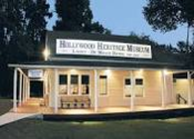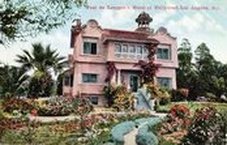 It's said that interesting places are actually characters in a story, and such is the case with Hollywood. Much of the satisfaction in writing a historical novel is getting to know the locations and what they were like at the time. Parts of Yours in a Hurry take place in Hollywood, and I was lucky to find the Hollywood Heritage Museum (pictured left) and experience its half-day behind-the-scenes historical tour of old Hollywood with Museum General Manager George Kiel. Richard Adkins, Museum Collections Manager, shared the following about Hollywood in 1910-1912 and how the museum keeps the mystique alive. The Hollywood Studio Arrives In 1910, Hollywood merged with the city of Los Angeles to be able to partake of the water and other city services available through the larger municipality. Hollywood was not yet famous for film, as its conservative prohibitionist founders had forbidden the exhibition of movies in Hollywood. Despite that restriction, film maker D.W. Griffith made the first film in Hollywood in 1909, "In Old California" starring Mary Pickford. Mr. Griffith used other locations, but his studio was located in the Edendale (now Silverlake) area of Los Angeles where it had been establish several years before. The prohibition of the sale or serving of alcohol in Hollywood inadvertantly gave birth to the first Hollywood Studio. The Blondeau Tavern, at the corner of Gower St. and Sunset Boulevard, had been a popular tavern and roadhouse until 1903. Owner Rene Blondeau passed just after the birth of the new city. The tavern remained vacant until Fall of 1911, when David Horsley of the Centaur Film Company of Baltimore, Maryland, had a chance meeting on the train with Frank Hoover, a photographer with a studio not far from Sunset and Gower on Cahuenga Blvd. Hoover learned that Horsley was heading to Los Angeles to establish a studio and suggested that the vacant Blondeau Tavern would make an excellent studio as there was one large building and several small cabins circling and open courtyard. This configuration adapted itself to a studio administration building, dressing rooms, and a place for an outdoor stage, as most films were still photographed out of doors. Mr. Horsley named his new studio the Nestor Studio and began business there in October of 1911. Nestor shot one- and two-reeler comedies and westerns, the first of which were "The Heart of a Racetrack Tout" and "The Law of the Range." Competition Seven months later, Louis Burns and Harry Revier gave Nestor competition when they opened a studio at Selma and Vine Streets, just one block South of the newly-christened Hollywood Boulevard (formerly Prospect Avenue). Renting a horse and auto garage from Jacob Stern, Burns and Revier established the first rental studio in Hollywood. Cecil B. DeMille of the Jesse L. Lasky Feature Play Company rented the studio the following December. Their project was to film a feature-length western at the studio, Hollywood's first feature-length film, "The Squaw Man." They started shooting December 29, 1913, and finished February 15, 1914. For their modest $3,000 investment, the three partners comprising the Lasky Company (Jesse L. Lasky; his brother-in-law, Sam Goldwyn; and Lasky's best friend and theatrical co-producer Cecil B. DeMille) made $300,000. Their success led hundreds of filmmakers to Hollywood. By 1919, Nestor became part of Universal Studio, and by 1917, the Lasky Company had merged with Adolph Zukor's famous player to become Paramount Pictures.  Hollywood Allure Initially the only tourist attraction in Hollywood was the art studio of French floral watercolorist Paul De Longpre. A trolley line, calling itself the "Balloon Route," would begin early in the day in downtown Los Angeles, then journey to Hollywood and stop at the DeLongpre art studio, and then venture on to Santa Monica and Venice, California, returning by day's end to Los Angeles. Of course, in time, the DeLongpre home and studio (pictured right) would also be drafted into service by the films. Griffith photographed "Love Among the Roses" at the DeLongpre home in 1909. Try as they might, Hollywood just couldn't resist the movies. The barn-studio where "The Squaw Man" was made is now the Hollywood Heritage Museum. It has traveled several places before arriving at its current location, across from the Hollywood Bowl. The museum features a recreation of DeMille's studio office and exhibits equipment, costumes, and props from silent films as well as artifacts of community history. Currently, a recreation of the outdoor stage used to film "The Squaw Man" is underway and will be in place by the Fall of 2015. Blanche nodded across the room."There's the royalty and the Photoplay photographer right behind them." All turned to see Pickford and Griffith across the room. Anna recognized Pickford from her films. Griffith looked sharply around the room with his deeply set blue eyes. She had wondered what he looked like in person. He was Addison's height, around six feet tall, with thick brown hair and a sharp nose that made him look like a handsome Roman figure. "I think we should go pay our respect," Ida said to Blanche. "I hear David is filming in the de Longpre's garden soon and I want to know how long it will disturb the neighborhood! Wouldn't you like to come, too, Anna?" Next time: More strong women- Lady Overland becomes a pilot.
0 Comments
|
Archives
August 2020
Categories
All
|
 RSS Feed
RSS Feed